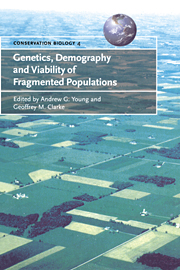Book contents
- Frontmatter
- Contents
- List of contributors
- Foreword by Peter F. Brussard
- Preface
- 1 Introduction: genetics, demography and the conservation of fragmented populations
- Part I Introductory concepts
- Part II Animal case studies
- 8 Inbreeding in small populations of red-cockaded woodpeckers: insights from a spatially explicit individual-based model
- 9 Genetic erosion in isolated small-mammal populations following rainforest fragmentation
- 10 The Tumut experiment – integrating demographic and genetic studies to unravel fragmentation effects: a case study of the native bush rat
- 11 Demographic evidence of inbreeding depression in wild golden lion tamarins
- 12 Inferring demography from genetics: a case study of the endangered golden sun moth, Synemon plana
- 13 Genetic population structure in desert bighorn sheep: implications for conservation in Arizona
- Part III Plant case studies
- References
- Index
12 - Inferring demography from genetics: a case study of the endangered golden sun moth, Synemon plana
Published online by Cambridge University Press: 29 January 2010
- Frontmatter
- Contents
- List of contributors
- Foreword by Peter F. Brussard
- Preface
- 1 Introduction: genetics, demography and the conservation of fragmented populations
- Part I Introductory concepts
- Part II Animal case studies
- 8 Inbreeding in small populations of red-cockaded woodpeckers: insights from a spatially explicit individual-based model
- 9 Genetic erosion in isolated small-mammal populations following rainforest fragmentation
- 10 The Tumut experiment – integrating demographic and genetic studies to unravel fragmentation effects: a case study of the native bush rat
- 11 Demographic evidence of inbreeding depression in wild golden lion tamarins
- 12 Inferring demography from genetics: a case study of the endangered golden sun moth, Synemon plana
- 13 Genetic population structure in desert bighorn sheep: implications for conservation in Arizona
- Part III Plant case studies
- References
- Index
Summary
ABSTRACT
The development and application of quantitative methods for assessing the viability and risk of extinction of populations requires considerable background demographic and life-history data of the modelled species and populations. Typically such data are difficult to obtain for most invertebrate species due to time or resource constraints. Quantitative sampling methodologies are not well developed for the bulk of invertebrate species and fieldbased estimates of migration, survival, fecundity, etc. are problematic. However the use of genetic-marker technologies such as allozymes and mitochondrial DNA (mtDNA) sequence data has the potential for inferences to be made about underlying demographic processes within and among populations useful for quantitative model development. In this paper I will show how such marker technologies have been applied to an endangered species of grassland-inhabiting moth, Synemon plana, to infer some fundamental life-history and demographic parameters.
INTRODUCTION
Effective conservation management of threatened species requires considerable detailed information on the life history, demographics and population structure of the taxa of interest. In addition, the development of quantitative models of population persistence [e.g. population viability analyses (PVA)] almost universally requires parameters such as generation time, fecundity, fertility, adult and juvenile mortality and migration as model inputs (e.g. Burgman et al., 1993; Lacy, 1993b). For many species, the acquisition of such data is not overly problematic (although may involve many years of detailed field work), and these are the same types of data used in the original determination of the species' threatened status.
- Type
- Chapter
- Information
- Genetics, Demography and Viability of Fragmented Populations , pp. 213 - 226Publisher: Cambridge University PressPrint publication year: 2000
- 6
- Cited by

